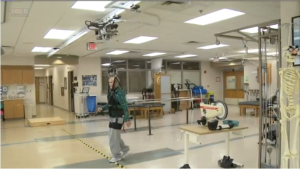ZeroG technology at Froedtert helps patients develop confidence
Source: Fox 6
Imagine having a headache, and the next thing you know you are in the hospital, having to learn basics like walking again. That’s the reality Joan Schacht woke up to.
“Everything’s changed now,” said Joan Schacht. Just a few weeks ago, Joan was an active 68 year old woman, used to doing everything on her own. But then in an instant everything changed. “Next thing I know I am in the hospital and I woke up and my head was all cut open,” said Joan. She woke up at Froedtert and the Medical College of Wisconsin and was told she had had a stroke. Joan went from doing things on her own to needing help- with everything. “I have to depend on other people to help me do things and watch me walk so I don`t fall and just everything I do has to be watched,” said Joan. And on top of that, Joan didn’t know how or if things would ever go back to normal. She didn’t know if she would ever walk again.
But then her physical therapist, Cheryl Vorwald introduced her to the ZeroG Overground Gait and Balance Training System. ZeroG is a robotic training system that holds up to 50 percent of the patient’s body weight to help them walk and learn how to balance again. “It was like a miracle to just get in that machine and walk along. You could walk, you could hop, you could skip,” remembered Joan of the first time she used it.
The patient is in a harness, which is attached to a 75-foot overhead track on the ceiling. The system makes up to 1,200 adjustments per second, and detects if patients start to fall and catches them to prevent injury.
“The first time you are afraid you are going to fall and crack your head open or something but then it catches you and you don’t fall,” said Joan. It also allows her personal trainer Cheryl to be a lot more hands on. The standard method without the system involves the physical therapist holding a gait belt while the patient practices walking. It ends up being more “artificial” that working with the ZeroG.
“When I take them and I can step back, they build that confidence and realize I am doing this on my own. The confidence and then their willingness to try other things increases and we can challenge them even further,” said Vorwald.
Froedtert Hospital has had this technology for about a year now. The money to purchase the system was donated to the Froedtert Hospital Foundation by the family of a patient who is deceased. Cheryl can see the difference the system has made in her patients, like Joan. Joan notices the changes it has made in her as well, both physically and mentally.
“You have control of your life again,” said Joan.




